You have a product or service you want to sell right?
The question is, who is going to buy it?
When you are starting a new business or startup, the question you should ask first is – who is my target market?
The secret of every successful company is knowing who is going to make use of their service.
Understanding your target market makes marketing much easier.
What would not knowing your target market cost you?
For starters, you would be spending a lot of money on a marketing campaign for a demographic of people that would not convert into leads.
Understanding your target market makes it easier for you to focus your ads and outreach towards customers that would convert.
Wasting your time on an audience that would bring low ROI would kill your company before you get the chance to even start.
This analysis on 101 post mortem startups would give you an idea on why startup fails.
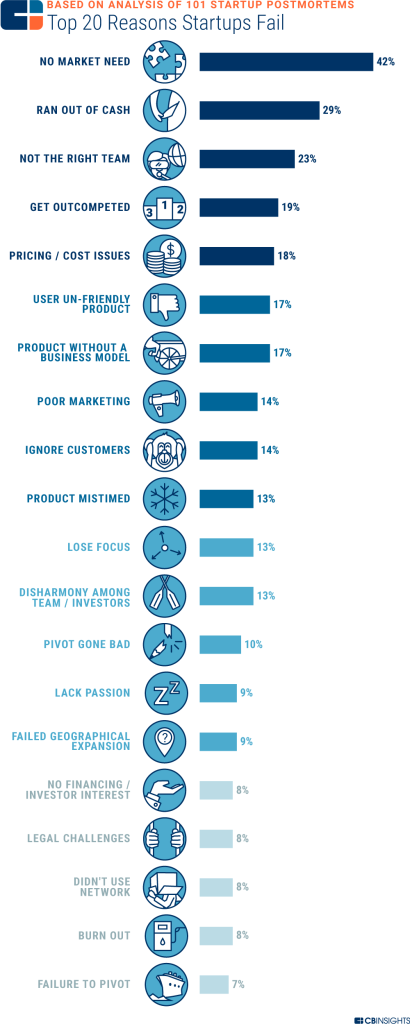
From the top of the list, you would see that the two reasons why startups fail is directly related to poor target research.
Reason #1: No Market Need
When proper market research is not done, you might end up creating a service that doesn’t have enough customers to make it profitable.
A problem might be interesting to solve, but that does not mean that there is a market for it.
One of the participants in this analysis had this to say,
“I realized, essentially, that we had no customers because no one was really interested in the model we were pitching. Doctors want more patients, not an efficient office.”
If you offer a solution that is not universal enough and also have the chances of scaling, there is every possibility of burning out fast.
Reason #2: Ran out of cash
This is directly related to a bad marketing campaign which is due to poor market research.
Spending millions on a campaign that is targeted to the wrong demographic would not generate any actionable leads.
Money that could have been spent on improving your product and hiring the best individuals to grow your company.
If money is not allocated wisely and used judiciously, the company would run out of funds fast.
Let’s start from the beginning.
Target Audience Definition
Your target audience is a specific group of people that you direct all your marketing endeavors towards.
The key term in that definition is specific.
Your target audience would have the following characteristics:
- They need your product and are willing to spend money on it.
- They are connected by common characteristics or,
- They are of similar demographic.
Marketers usually have a saying – “if you build it, they would come.”
I fully agree with this statement, but the truth is nobody would come if you do not target the right audience.
There are plenty reasons why should invest time in finding your target audience, but here are the top three according to CoSchedule:
- You would be creating the right content for the right people.
- It would be easier to create content that would connect benefits to user’s needs.
- Because you have done 1 and 2 right, you would be able to increase conversions.
Understanding Your Target Market
To understand your target market, they are certain key questions you would need to answer:
What problem are we trying to solve with our product or service?
For a case study we would making use of Tesla.
In the Tesla official website, the aim is clearly stated:
Tesla’s mission is to accelerate the world’s transition to sustainable energy
That is just the abridged version of their goal and vision.
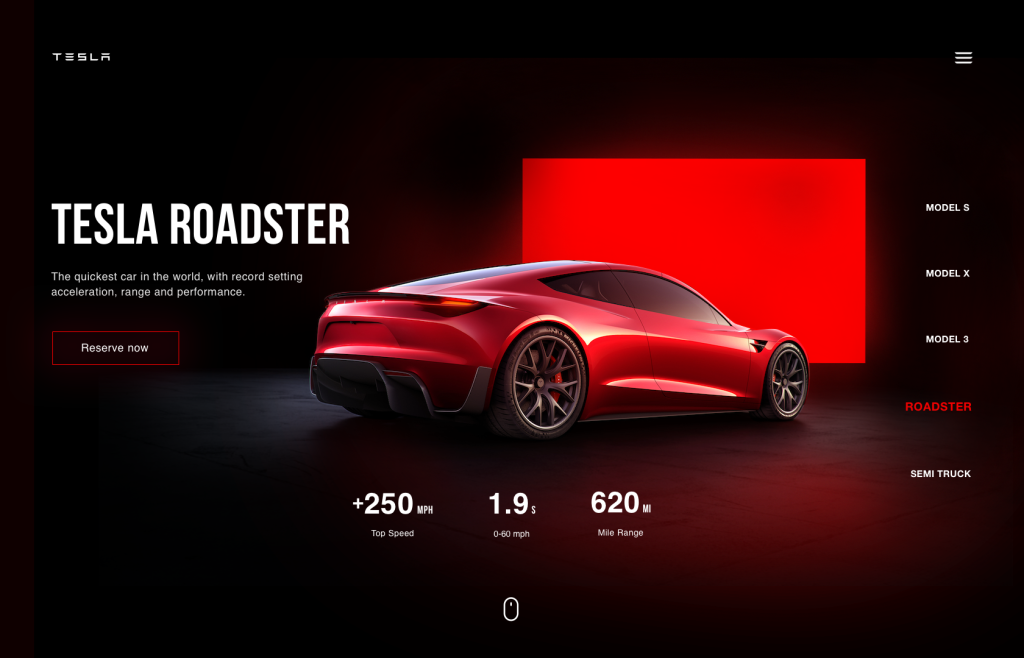
Tesla has a clear vision of what their company is all about.
They understand what problem they are trying to solve and how their services can be beneficial to users.
You should understand the reason why your service exists.
If you cannot say for a fact that your product answers question x, y or z, then it is time you go back to the drawing board.
Who are your competition?
You most likely know the biggest brands that might be your competition.
Knowing the biggest names in your industry would not be enough.
There would also be mid tier brands that would be a direct competition to you in comparison to the big names.
It would be difficult to start competing with Fortune 500 companies right out of the bag.
You should concentrate on crushing the competition that is on par with you and scaling from there.
A quick google search or scouring social media sites like Facebook and LinkedIn can help you get started.
Researching on the keyword related to your industry on google is easy to do.
“Keyword” + company.
For example “electric cars” + company.
After you have gotten a list of these companies, find their company website and go to their “About us” page and feature descriptions.
This would give you a good idea of whi the competition is.
Doing detailed research on your competition would lead to the final question:
Why would customers want to choose you?
- What makes you different from other brands in your industry?
- What services do you offer that others don’t?
You wont be able to answer these questions if you have not done a detailed analysis of your competition.
This isn’t the whole process, it is just the starting point to finding your target audience.
Further reading:
- Productivity System: The Definitive Guide
- 10 Powerful Business Goals to Set
- 8 Best Employee Monitoring Software for Large and Small Businesses
- Check out the 26 best podcast hosting sites on the internet.
Important Strategies For Finding Your Target Audience
1. Start with a wider group and niche down gradually
Don’t make the mistake of niching down right from the beginning.
You might miss a key demographic of your users in the process.
First start with a wide range of people and you can gradually narrow down your focus as you proceed.
The best way to get a good idea of your target audience is by starting with three most important categories:
- gender
- age
- location
When you take these broad groups into consideration, you would be able to do elimination easily.
They are certain product that are mainly for the female demographic.
For example is the Fenty beauty product line.

Their product line includes things like lips sticks, foundations, makeup brushes for all women with different skin shades and colors.
The Fenty beauty line would have a primary target audience of women.
It would be a waste of time and resources if they made men their target audience.
Not like men cannot purchase these items, but they constitute an insignificant number of users.
Alongside the primary gender for the product, we can further narrow down to the key age demographic of users of the product.
You can assume that young teens and senior citizens would not be using this product a lot.
So your target market would further niche down to girls above the ages of 18 and women below the age of 60
Now you know who to target your marketing campaign towards now.
As you read on further, you would still niche on further until you have a tight idea of your user demographic.
2. Engage Customers
Narrowing your focus group and analyzing your competition can only get you so far.
The customers are the most important part of any business after the product/service.
To understand your target market extensively, you would have to talk with your customers.
It is possible that the assumptions that you have are wrong.
Use the focus group that you already have to conduct tests.
In the case of Fenty, just saying that their target market is women from the age of 18-60 won’t be efficient.
That is a huge number of people. It is important that you find ways to further segment these numbers.
Here is an explanatory graphic to help you narrow your target market better.
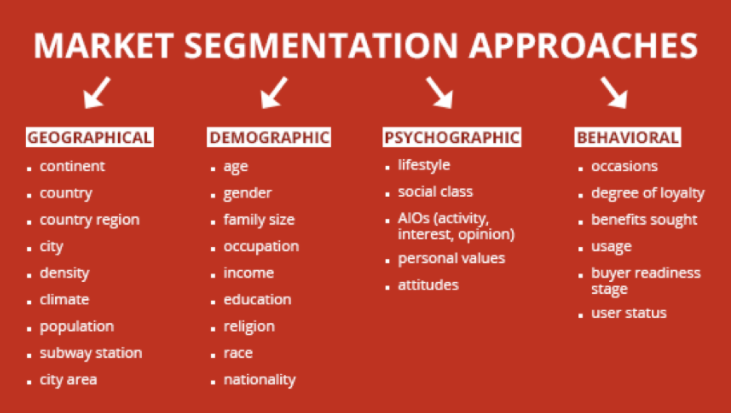
Using this approach, you would have a more rounded idea of who your potential customers are.
To get started, you should create a focus group.
Each focus group should have 7 – 10 participants in them.
For each group, show them the services and product that you want to offer to the market.
Gauge their reaction to these products and see how receptive they are to them.
For the individuals that exhibited a positive reaction, find out want made them love the product.
Do the same thing for those that exhibited a negative reaction.
There are several reason why they might displayed these reactions.
Here are some reasons they might not react favorable to your product:
- Social class or annual income: Your product might not appeal to them because of the price range.
- Lack of understanding: Price isn’t the only reason they might not be interested in your product. If they don’t know if the product would benefit them, they would not buy.
- They deem it unnecessary: What does your product satisfy? Does it save time? If you want them to make the guesses on their own, there is a huge chance they wouldn’t bother.
It is important that you find out as much detail of your focus group.
You would use the information gotten as a template for the general market population.
Understand that just one interview session isn’t enough.
The market changes from time to time, so market research is an ongoing process that should be done regularly.
The more of these interviews you hold, the more accurate your analysis of your target audience would become.
This would help you know how to target your audience better and optimize your services for them.
3. Create Buyer Personas
You might not have heard of the term customer or buyer personas before.
This is a simple definition of buyer personas.
A buyer persona (a.k.a. “customer avatar”) is a fictional person who represents a particular company’s ideal customer
The main reason why you would create a customer persona is so that you can have a vivid idea of who your target audience is.
If you don’t know who your buyer is, it would be impossible to make a sale.
Depending on your product, you can have more than one buyer personas.
Different types of people might use your products, so you would have different buyer personas for them.
This is an example of buyer personas:
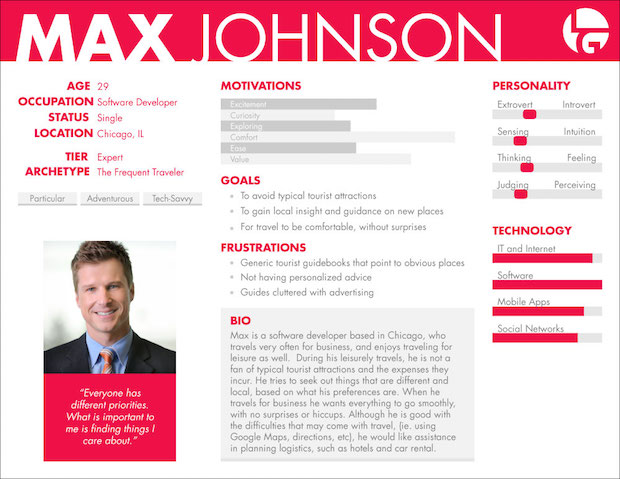
Understand that the buyer persona should be specific to your company.
Don’t use a generic template.
There are certain tools you can use in creating buyer personas.
1. Xtensio’s User Persona Creator
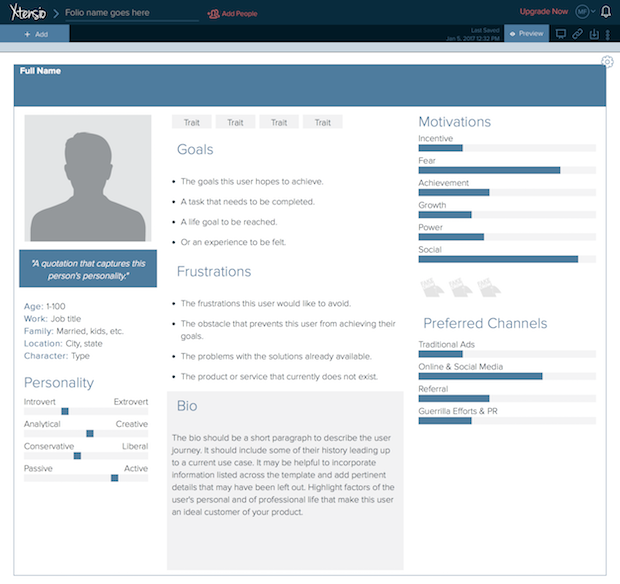
Xtensio’s User Persona Creator is a handy tool that gives you a template that includes customer goals, personality, frustration, motivations and preferred channels.
2. HubSpot’s Buyer Persona Template

The HubSpot’s buyer persona template contains four sections that helps you answer the who, what, how and why on you customer demographic.
3. Filestage’s Buyer Persona Template
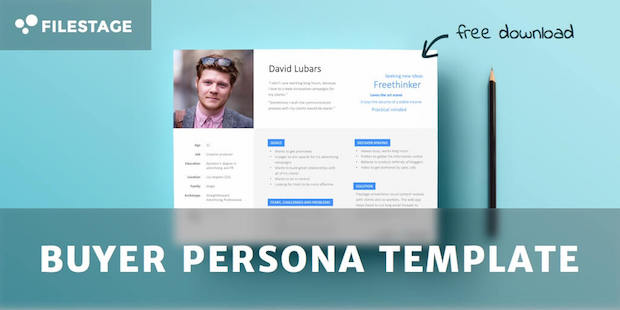
Filestage’s Buyer Persona Template is a well designed tool that gives you a nice template to create your buyer persona. It also comes in PowerPoint and PDF versions.
60 Some questions you can ask to create buyer personas:
By Demographic:
1. What is your name?
2. What is your gender?
3. What is your age?
4. Where do you live?
5. What is your occupation?
6. How much do you earn annually?
Backstory
7. Where were you born?
8. Where do you grow up?
9. Who raised you?
10. Are your parents still married?
11. Do you have siblings?
12. Did you attend college?
13. If you did, what course did you major in?
14. If you didn’t attend college, what did you do after high school?
15. What was your first job?
Personal Life
16. Are you married?
17. Do you have children?
18. If you do, how many are they and what are their age range?
19. Are they boys or girls?
20. Do the kids live with you?
21. If you don’t have any kids, do you plan on having them in the future.
22. Do you have pets?
23. If you do have pets, how many are they and what kind of pets?
24. What kind of house do you live in?
25. Who is living in the house with you currently.
26. Are you close with your extended family?
27. Do you have friends, how many are they and how far are they from you?
28. Are you a religious person?
29. Do you play sports?
30. What is your favorite TV show or movie?
31. What is your best hobby?
32. What is the first thing you do in the morning?
33. Do you cook at home or do you eat out?
34. How do you spend your weekends?
35. Where do you like to shop?
36. Do you take coffee?
37. Do you smoke?
38. Are you tech savvy?
39. Do you like traveling?
40. Where do you go on vacations?
Career
41. What industry are you in?
42. What is your job description?
43. What is the size of the company?
44. Who do you report too?
45. What kind of tools do you use in your job?
46. What is your salary?
47. Do you receive any compensations?
48. Are you enjoying your job?
Finances
49. What is your net worth?
50. Do you have any debts?
51. Do you carefully man plans before making purchases?
52. What drives you to make a purchase?
53.What it your spending habits like?
54. Who is the breadwinner of your home?
55. Are you in charge of making the financial decisions in your home?
Goals/Challenges
56. What are your long term and short term goals?
57. What do you want to gain from using our product?
58. What are top five items in your bucket list?
59. What item have you bought and regretted the most?
60. What activities do you find as stressful?
With all these tips, you can go ahead and create your own buyer personas.
4. Conduct User Surveys
The moment your startup starts to make sales, you can begin to conduct user surveys.
These surveys should be done regularly.
You can make use of a free tool like survey.io to get started.
Customer surveys would give you a good idea of your target audience and what they expect from you.
In the instances where customers stops using your service, you would know why because of your surveys.
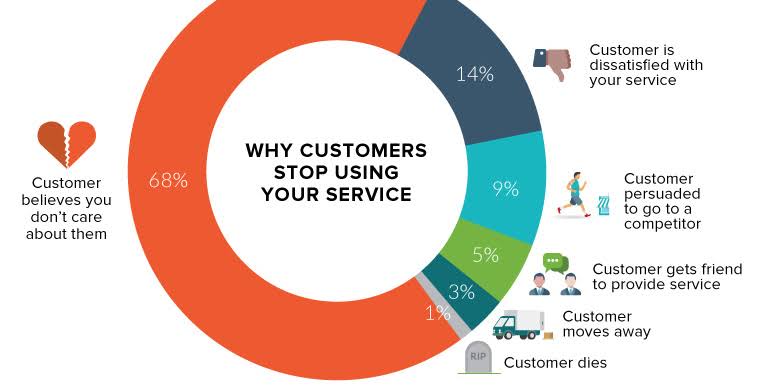
It is from the results of these surveys that you go about finding your target audience efficiently.
Remember I said earlier in this article that market research is an ongoing process.
The market changes from time to time, so these surveys are important.
A good survey should be short and straight to the point.
It should ask questions related to:
- demographics
- geographic location
- psychographic traits
- behavioral trends
Hint: Adding a freebie to your survey might help to increase participation.
5. Make Use of Google Analytics
Google analytics contains a ton of information that you can use in finding information about your audience.
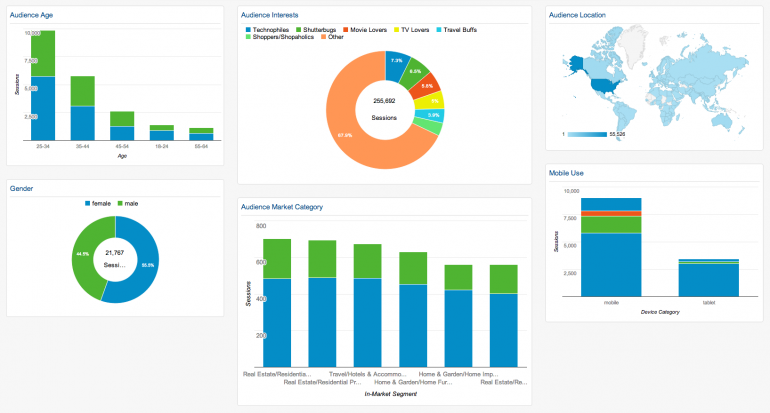
Some of the data you should be checking includes:
#1 Demographics: Age and Gender
With google analytics, you can have a good idea of your audience demographic. This would include their age and gender.
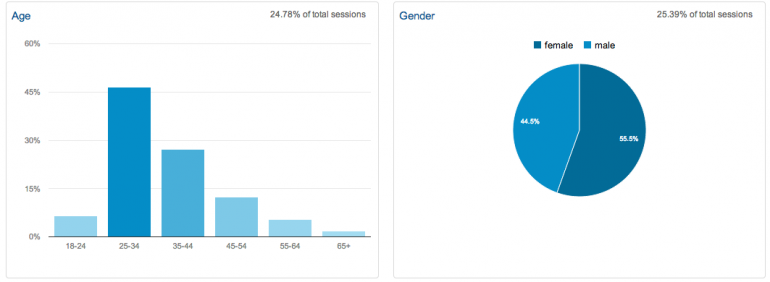
#2 Interests
With google analytics, you can find out which topics your users are most interested in.
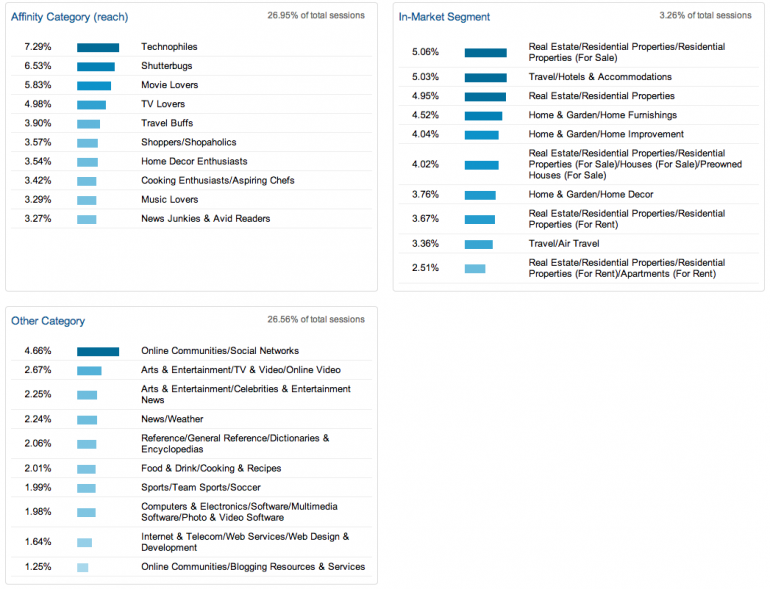
Knowing your audience interests not only helps you with creating content but also when creating ads.
Knowing what categories your users interacts best with, would help you create more targeted ads.
#3 & #4 Geography and Location
Knowing that location of your users would help you create campaigns that works well in their culture.
Some usefulness of knowing your audience geography and location:
- Avoid making cultural/social blunders related to the location your users reside in.
- You would know how to plan for holiday season content.
- You would avoid phrases or content that could confuse your users.
6. Talk to your social followers
Being active with your users on social media would give you a good idea of who your target audience is.
These are some tips you can follow:
- Try responding to every content or interaction you receive. This would help you learn more about your audience.
- Find groups related to your industry on Facebook and LinkedIn and create connections. This would give you an insight on what is important to your audience.
- You can occasionally send social media posts asking your users what they are interested in.
Conclusion
You can see that finding your target audience isn’t a day’s job.
It takes time and effort but it is worth it.
At the beginning of the process, you might make general assumptions because you do not have sufficient data yet.
Start to niche down as you progress on until it fits your industry, brand and products.
Engage your customers with surveys and interviews so that you can get an in depth knowledge of what drives them.
Use tools like ahrefs to analyze your competitors. You would see who they are targeting in your industry.
You can decide to follow in their footsteps or do something different.
When you begin to have customers, create surveys regularly.
Creating buyer personas would help you to focus more on your users and their specific needs.
Make use of google analytics to find out the demographic of users that are visiting your website.
Interact as much as you can with your followers on social media. Do not just guess what they might like, engage with them and find out.
Continue to adjust your data continuously to ensure efficiency.
Now its your turn to get started. Good luck.
